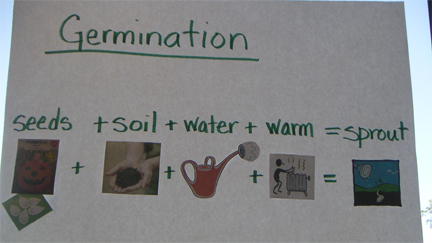I decided to try a science experiment with our Kindergarten students. One of the Massachusetts Science Standards for these children is to understand the Life Cycle of the Pumpkin. What better way to understand this standard, than to become scientists and plant pumpkins. So that is what we have done – in the library of all places!
We researched growing pumpkins with our kindergarten students and then each of our Kindergarten classes planted 4 or 3 pumpkins seeds in a container. We referred back to our notes from our research and knew what we needed to begin growing pumpkins. We then added stones to the bottom of a container, dirt, then our pumpkin seeds and finally we watered them. We put them in a warm corner of the library. We learned that in order for seeds to germinate, they needed soil, water, and warmth. Check out our Rebus showing what germination is:
We couldn’t believe it when 8 days later, 2 of the classes pumpkin seeds had germinated! The two classes who planted their seeds three days later, were a little slower to germinate. We tried to figure out why. We decided that the AC in the library was too cold and the seeds didn’t have enough warmth to germinate. So I brought in my warming tray and put the pots on this for two days (school hours only). In two days the seeds germinated! The K-scientists were excited that they had figured out the right solution.
Our Kindergarten scientists have been checking their pots once a week. They have been writing their observations on how many leaves each plant has and how tall the plants are. Then two K-scientists, draw a picture of what they observe; just as real scientist do. Here are some examples:
 This pot contains 4 pumpkin plants (all 4 seeds germinated). They have just started to put out their ‘real’ pumpkin leaves. The K-scientists are very excited. They cannot wait to check their plants each time they come to the library. We use a flex video cam to look closely at the plants, which we project on the wall so that all scientists can see and contribute to our observations.
This pot contains 4 pumpkin plants (all 4 seeds germinated). They have just started to put out their ‘real’ pumpkin leaves. The K-scientists are very excited. They cannot wait to check their plants each time they come to the library. We use a flex video cam to look closely at the plants, which we project on the wall so that all scientists can see and contribute to our observations.
This pot, on the right, is one of the pots that was slow to germinate due to the cold AC in the library. In just a couple of days it grew this tall. It is amazing what will happen when the right conditions are present.
 Here are two examples of the charts and drawings the K-scientists are keeping on each pot of pumpkin plants.
Here are two examples of the charts and drawings the K-scientists are keeping on each pot of pumpkin plants.
I wish to thank Lovell’s Flowers, Greenhouse and Nursery in Medfield, MA for donating the pumpkin seeds, pots, and soil for our Kindergarten scientists’ experiment. I would especially like to thank Ryan for his patience, as I asked what I’m sure he thought of as “endless” questions, exploring this idea and deciding it was too good, as a learning activity, not to try.
Next big challenge … hoping for pumpkin flowers and we can teach the children about “pollination” … the birds and the bees anyone? I have been doing a lot of reading and now know that pumpkin plants produce both male and female flowers … did you know that? Since we are growing these inside (it is New England in the Fall), we will need to become the pollinators … no bees inside please!
Please check back often and see how our scientists are progressing in their experiment … Can we grow pumpkins inside in the Fall? 120 days to harvest … only 102 days to go………
Happy Growing!
Kindergarten Scientists and Mrs. Chase



